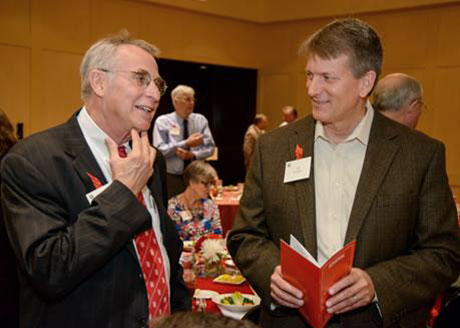William Fitzgibbon and Jeff Morgan Develop Model as System of Differential Equations
Mathematics professors William Fitzgibbon and Jeff Morgan tracked the spatial spread of diseases long before COVID-19 gripped the world.

Fitzgibbon said that his collaboration with Morgan, who is now University of Houston associate provost for education innovation and technology, extends well back into the ‘80s.
Over the years, the two University of Houston College of Natural Sciences and Mathematics professors have collaborated on a variety of topics, including the use of systems of partial differential equations to model and track the spread of various infectious diseases across geographic areas.
Fitzgibbon explains that differential equations have been used to model the course of infectious diseases and how they circulate through a population since the 1930s.
However, as models become more realistic, “the systems for differential equations become much more difficult to analyze,” Fitzgibbon said. “The more complex the model, the more analysis.”
He and Morgan were invited to work on research related to COVID-19 because of their history of research on epidemic-related problems and recently had papers on the coronavirus spread accepted into medRxiv and the Journal of Biological Systems.
Modeling the Spread of the Coronavirus in Brazil
Along with researchers from Vanderbilt University and Middle Tennessee State University, they published Predicting the End-Stage of the COVID-19 Epidemic in Brazil in medRXiv. In the paper, they develop a dynamic model of a COVID-19 epidemic and compare it to the current COVID-19 epidemic in Brazil. Their model incorporates an asymptomatic infectious stage and a symptomatic infectious stage.
When the paper was written in June, Brazil was in a rapid growth phase, with limited social distancing measures, and limited compliance with the measures, making it particularly interesting to study.
“The second paper begins to develop the methodology and the underlying mathematics to describe the spatial spread,” Fitzgibbon said.
In the second paper, the group develops and analyzes a model to predict the outbreak and spread of the disease through space and time.
They also “introduce a cross-species transmission model that accounts for the disease being supported by an animal host.”
Their collaborators at Vanderbilt and Middle Tennessee State focus on numerical analysis, “to show that the mathematical model actually does mimic the aspects of the disease that you’re hoping to capture,” Morgan said.
Morgan and Fitzgibbon are now working on a third paper, which looks at the different ways that people and the disease move about in various regions in Brazil.
Possible Practical Application
“Faculty members at universities have the best jobs in the world,” said Morgan. “We get an opportunity to do research and nobody is telling us what we have to do research on. Some people like to do crossword puzzles – I think Fitzgibbon and I would do this for free. We enjoy working on these types of models.”
Morgan points out what makes it even more enjoyable is the fact that he and Fitzgibbon are friends.
Their contributions could help people around the world. Fitzgibbon said one possible application of their research would be if medical officials use their models to allocate resources like ventilators for hospitals.
Both their papers are co-authored with Glenn F. Webb of Vanderbilt University and Yixiang Wu of Middle Tennessee State University, who are corresponding authors.
- Rebeca Trejo, College of Natural Sciences and Mathematics